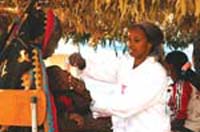
The Health Belief Model (HBM) is a model at the individual level that has been used to explain change and maintenance of health-related behaviours. You will be able to use it as a guiding framework for your health education work, especially during any health behaviour interventions.
The Health Belief Model has four major concepts. It assumes that people will take action to prevent or to control ill-health if they regard themselves as susceptible to the condition (perceived susceptibility). Also they will take action if they believe that the condition will have potentially serious consequences for them (perceived severity), and if they believe that the course of action available to them is beneficial in reducing their susceptibility to, or severity of, the condition (perceived benefits). They also need to believe that the anticipated barriers to taking the action are outweighed by its benefits (perceived barriers).
Think of an illness that you have experienced. Now using the questions below analyse your experience in terms of the Health Belief Model:
Because the HBM is so closely based in individual experience it is easy to use it to think about illnesses we have had. Did you find that all four questions were easy to apply to your own experience of illness? Also, because it works so well as a way of thinking about our own experiences, going through the elements of the HBM should help us understand some of the influences on the health beliefs of other people in our community.

Before you move on, just check now that you know the assumption and the four major concepts that are central to the HBM?
The HBM assumes that the most important determinants of people's behaviours are their beliefs or perceptions. There are four major concepts related to perceptions and beliefs: perceived susceptibility, perceived severity, perceived benefits and perceived barriers.
Let us consider this now in a practical context. According to the HBM, a young, single individual is most likely to attend for an HIV test if the following applies:
Therefore if you are applying the HBM in designing health education sessions about the importance of HIV testing, your role as a health educator will be to teach people about:
Read the description above again, which sets out the HBM in relation to HIV/AIDS. Now consider the following situation. Assume that you are planning to educate Ato Abebe, a member of your community, on how to prevent malaria using a teaching session based on the Health Belief Model. How you would use the HBM to help you design your health education session?
If you want to apply the Health Belief Model in designing your health education session on preventing malaria, the first step will be to identify Ato Abebe's personal beliefs according to the components and assumptions of the HBM.
You could ask Ato Abebe the following questions that are based on the HBM:
Based on the answers that you get from Ato Abebe you can develop your health messages as follows: